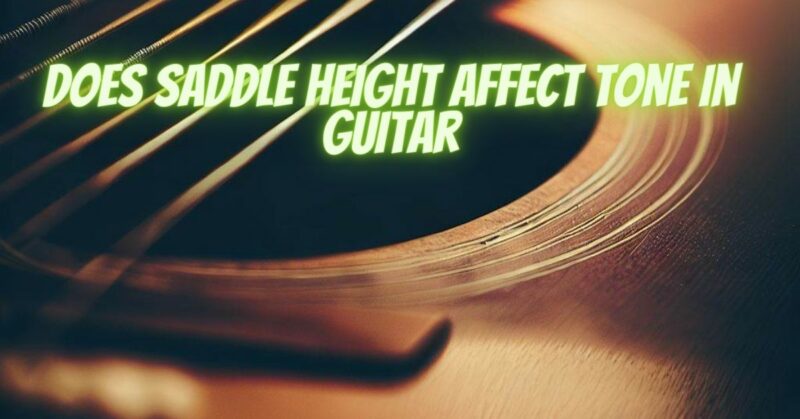The quest for the perfect guitar tone has captivated musicians for generations, driving them to explore every nuance and component of their instruments. One such element that plays a significant role in shaping a guitar’s tone is the saddle height. This seemingly minor adjustment can wield a substantial impact on the sound and playability of your guitar. In this article, we’ll delve into the fascinating world of saddle height and its profound influence on the tone of a guitar.
Understanding the Saddle and Its Role
To appreciate the effect of saddle height on guitar tone, it’s essential to understand the saddle’s function and placement:
- Saddle: The saddle is a small component, often crafted from materials like bone or synthetic alternatives, situated on the bridge of the guitar. It acts as the point of contact for the strings, transmitting their vibrations to the guitar’s soundboard, where the magic of music begins.
How Saddle Height Affects Guitar Tone
Saddle height is a critical variable that significantly influences a guitar’s tone in various ways:
- Tonal Balance: Altering the saddle height can shift the tonal balance of the guitar. Raising the saddle increases string tension, resulting in a brighter, more pronounced treble response. Conversely, lowering the saddle reduces tension and produces a warmer, mellower tone with enhanced bass frequencies.
- Volume and Projection: Saddle height also plays a vital role in energy transfer from the strings to the soundboard. A higher saddle provides greater string-to-soundboard contact, contributing to increased volume and projection. A lower saddle may yield a quieter, more intimate sound.
- String-to-Surface Contact: The saddle’s height affects the point of contact between the strings and the saddle itself. A well-balanced saddle height ensures even string-to-surface contact, enhancing note clarity, sustain, and harmonics.
- Action and Playability: Saddle height directly influences string action, which refers to the distance between the strings and the fretboard. A higher saddle raises the strings, potentially making the guitar more challenging to play. Conversely, a lower saddle can result in a more comfortable playing experience but might affect playability and lead to string buzz.
- Harmonic Overtones: Adjusting the saddle height can impact the harmonic overtones produced by the guitar. Different saddle heights may emphasize specific harmonics, adding complexity and character to the overall tone.
Factors Influencing Saddle Height
Several factors can influence saddle height and, consequently, the guitar’s tone:
- String Gauge: The thickness of the strings exerts a significant influence on saddle height. Heavier gauge strings require more tension, often necessitating a higher saddle to maintain proper action.
- Playing Style: Your playing style, encompassing techniques like fingerpicking, strumming, and flatpicking, can interact with saddle height to produce various tonal nuances.
- Guitar Setup: A well-set-up guitar with the correct saddle height ensures optimal tone and playability. Nut height, neck angle, and other setup factors also play a role.
- Material and Design: The choice of saddle material and the guitar’s overall design can influence how saddle height impacts tone.
Experimenting with Saddle Height
To explore the influence of saddle height on your guitar’s tone:
- Consult a Professional: Seek the expertise of a luthier or guitar technician to make precise saddle height adjustments tailored to your desired tonal goals.
- Try Different String Gauges: Experiment with various string gauges to find the combination that works best with your saddle height adjustments.
- Play and Listen: Spend time playing your guitar and carefully listening to the tonal changes resulting from saddle height adjustments. Pay attention to brightness, warmth, volume, and playability.
- Recording and Comparing: Record your guitar with various saddle heights to objectively compare the tonal differences.
Saddle height is a vital element in shaping the tone of a guitar. Understanding how saddle adjustments affect tonal characteristics, playability, and projection can empower you to fine-tune your instrument to match your musical style and artistic expression. Whether you seek a brighter, more pronounced tone or a mellower, warmer sound, saddle height adjustments offer a versatile tool for achieving your desired guitar tone.


